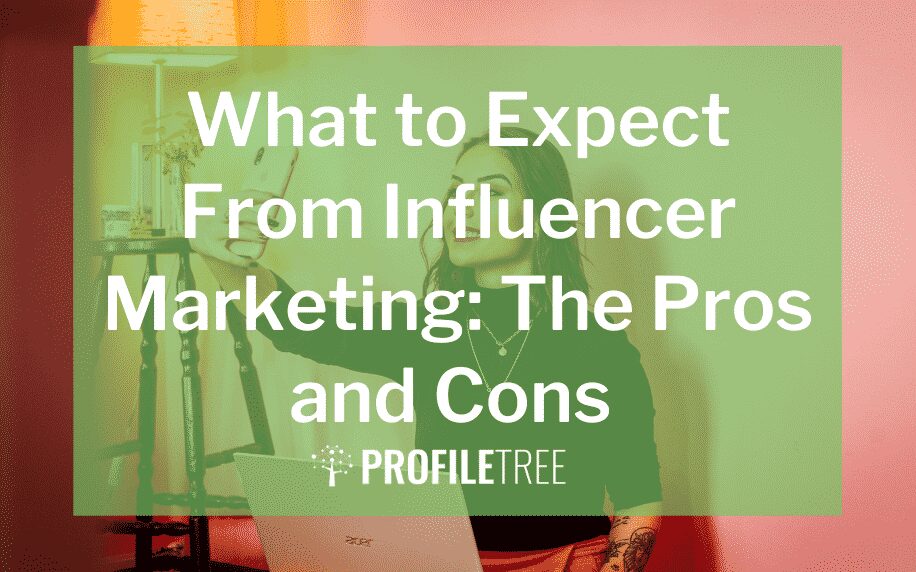Influencer marketing is a specific market in which social media influencers are the advertisers. Essentially, the influencers endorse products on behalf of the brand that has hired them. Instead of advertising directly to a large group of consumers, a business or brand will hire an influencer to create social media content involving the product. The influencer’s followers will then see this endorsement of the product or brand, and in the case of successful collaboration, this will generate awareness and sales for that company.
Social influence marketing is a very useful tool for brands and companies because it can be used to make trends and encourage influencer’s followers to buy their products. When used effectively, it is a relatively low risk marketing strategy to reach a well targeted audience. Brands often love to use social media influencers to market their products as social media is such a widely used platform, and many people will see the influencers’ endorsements. In the Uk alone in 2020, 45 million active social media users were recorded.
It is useful to think of this market as a straightforward advertising market. We can see that the companies who make use of influence marketing are the product providers and that the social media influencers are essentially their own advertising agencies. We can say that this is a fairly straightforward market once we see that the product that is being paid for is the influencer’s expertise and their engagement with their audience. The aim of the brand is that these will equate to more sales for them and more engagement with their own company.
Of course, the bigger the following they have, the more likely it is that an influencer will actually have their own agent who will negotiate any marketing deals for them, however the smaller ones are less likely to. This is something that companies will have to consider when choosing whether to make use of social media influencers in their marketing strategies or not. In this article we will discuss the benefits and potential drawbacks of working with social media influencers.

Table of Contents
The Pros of Influencer Marketing
Influencer marketing can transform your business. Here are some of the positives to incorporating it into your strategy:

1. Their Seal Of Approval Is Meaningful
Influence is built on a mechanism of trust and likeability. There is a connection between an influencer and their audience which is valuable because it implies shared interests and values. When an influencer endorses a product or brand, they are using this connection to ensure that their audience is aware of the product’s values and the brand’s overall character.
This means that when an influencer endorses something on their social media, their seal of approval holds significant value for the company being advertised. When the influencer has a genuine connection with their followers, this results in more sales or engagement with the advertised brands.
One example of a very successful influence marketing campaign on the social media platform Snapchat was the Dunkin’ Donuts campaign with several micro-influencers on National Donut day. This content saw a total of 3 million views across the influencers’ platforms, and Dunkin’ Donuts had 10 times their monthly average of new followers in a single day.
This is a great example of how successful social media campaigns can boost brand engagement. It was also part of the resulting success that the product and campaign were carefully matched to the influencer’s values as lifestyle content producers.
2. Direct Access To Specific Audiences
Social media influencers usually have a dedicated and distinct following who share many of the same interests as them. This is because consumers obviously follow accounts that relate to their areas of interest and passions.
What this means for companies and brands using influence marketing strategies is that their campaigns can allow them direct access to specific audiences. For example, if they are looking to promote a product or event related to the music industry, they will effectively reach the relevant audience if they use an influencer who has expertise in that area. Another significant benefit of influence marketing is the boost to brand awareness.

3. A More Intimate Way Of Advertising
Influencer marketing is a much more targeted and swift method of advertising that traditional advertising techniques. Online, print and billboard adverts for example are much more generalised to a wider audience, and operate on a more widely distributed level in the hope of attracting more customers.
Influence marketing on the other hand is much more carefully targeted, and brands have a lot more control over which groups they are getting their promotion through to. When they choose an influencer to work with, they have a good understanding of which demographics make up that influencer’s following. This means the brand can more effectively match their products to their audience with this more intimate form of advertising.
4. Different Types Of Influencers
It is worth keeping in mind that there are a variety of types of influencers. These are often categorised by a number of followers, into mega, macro, micro and nano influencers. It is not necessarily the case however that more followers mean better engagement. Micro and nano influencers, while they have fewer followers, often have a far more dedicated and specific following too. They are also often more able to engage with all of their followers and share their expertise with them.
Some good examples of nano influencers are the fashion company Boohoo’s student campaigns. These involve nano influencers such as @hannachambers_ posting content of their outfits and promoting the brand. It is also worth noting that micro and nano influencers are likely to demand less creative control of the posts than their larger counterparts.
Another thing for a brand to consider is whether they want to take advantage of a more general audience or a more niche and specific one. It might even be a consideration for a brand to hire multiple smaller influencers and reach a more targeted yet spread out audience. It is also worth mentioning that while Instagram is currently the most widely used platform for social influence, other platforms can be used, such as Facebook, Pinterest, Google and increasingly TikTok.
Depending on the product, a company can use different types of influencer to reach a certain size of the audience. This is another way in which brands have excellent control over this method of marketing.

5. Instant Results
Brands can easily see instant results when they work with influencers on social media. This can be done by using swipe-up links to view click-through rates, analysing changes in follower counts and monitoring sales. Brands can also instantly gauge the results of their campaign by using the influence market calculator, which divides the return by investing in the campaign. These are all ways for brands to ascertain their campaign’s ROI (Return On Investment).
Influencers can also generate direct sales with companies using the process of affiliate marketing. This involves the influencer promoting a code specific to their social media channels, for example, “MYCODE20” for a 20% discount at a certain website. This is often used when an influencer has a partnership with a certain brand, and are not necessarily hired for just one campaign.
A good example of this is the Instagram body-positivity influencer Emily Clarkson’s partnership with sportswear brand Sweaty Betty. She often reviews their products, and promotes affiliate marketing codes such as “SBEMILY20”.
The Cons of Influencer Marketing
While there are plenty of positives to influencer marketing, there are some issues with it too. Here are some to keep in mind:
1. There Is No One Size Fits All
We have already mentioned that different types of influencer can be used to promote different types of product, but this can also present a challenge for brands who are looking to promote themselves through social media influence. They may want to use a variety of influencers for a specific campaign, and in this case it can be fairly difficult to match up the sizes of followings and keep track of which audiences the campaign is being exposed to.
This can mean that a brand does not face an easy choice when it comes to deciding what type of influencer to hire. They will need to consider whether they would rather use an influencer with a larger following in the hope of reaching more people, or whether it would be more beneficial to hire a number of smaller influencers who have a more targeted approach and more engagement with their followers. Ultimately, a company will have to decide this depending on their campaign, product and goals.
2. Following Does Not Necessarily Equate Into Engagement Or Sales
When a business makes the decision to approach an influencer, they must consider how effective that influencer might actually be. A high number of social media followers does not automatically equate to audience influence and influencer status. There are many other considerations and signifiers as to whether a person is influencing their audience’s behaviours. This might come down to how many of their followers actually follow and share the links they post, engage with the pages and brands they promote, or use their discount codes for example.
A true social media influencer is someone who actually engages with their followers and has a decent level of expertise on the product area.Celebrity status or familiarity with wide audiences is often confused for true influencer status on social media. For example, a reality tv star may have millions of followers, but if she/he does not engage with them, or promote brands and products that would actually appeal to those followers, they might not be influencing any consumer habits at all and therefore, they are not true influencers.
3. They Charge Different Prices
As there is such a variety of sizes of influencer, so the prices they charge vary hugely too. The costs can vary greatly depending on the industry, size of the campaign, and number of followers the influencer has. There are many variables in the market, and no two influencers charge the same rates, but it is estimated that in general an influencer will charge roughly £5-10 per 1,000 followers. However, engagement must also be taken into account, and an influencer with 1,000 followers may charge the same as one with 10,000 followers for the same content.
Another thing to keep in consideration for brands is that larger influencers are more likely to have an agent to negotiate any marketing deals for them, while smaller influencers might not have this step in the process. Either way, a lot of time and effort is needed to allow a brand to properly decide which influencer is the best fit for them.
4. Influencers Require Vetting
Whilst social media influencers can be a great tool for the brands and companies who use them, there is a risk of scandal and doing damage to the brand if the influencers are not carefully considered. The good news is that this can easily be avoided if a brand takes the time to carefully consider whether their values and ethos matches up with those of the influencer they are considering.
If influencer marketing is not done right, it can do irrevocable damage to the brand. This is why it is so vital for a brand to vet their influencers first and check that their values are aligned. They should also do their best to check that an influencer’s followers are mostly genuine, as some do pay for their followers and this means less real engagement.
Another significant example of a social media influence campaign that went wrong was the case of Luka Sabbat, who came up against a lawsuit when he failed to uphold his end of the bargain on his collaboration with Snapchat’s Spectacles product. It seems the influencer and company were not quite on the same page when it came to the terms of the deal they struck, and the consequences were costly for both. This is a very good example of why influencer candidates need to be carefully vetted by brands thinking of working with them.
5. Influencers can misuse their power, and things can go very wrong
When a company gets a social media influence campaign wrong, the implication for their business can be significant. One of the most high profile influencer scandals was the Fyre Festival scandal in 2017. Extremely high profile influencers were hired to promote this event on a private Bahamas island, which ultimately turned out to be a fraudulent event which never happened as advertised. As a result of this scandal, confidence in influence marketing dropped dramatically for a while. This was a good example of potential drawbacks of the market: when the advertisers are promoting a product that fails or does not meet the promised quality.

Using Influencer Marketing
When weighing up the pros and cons, influencer marketing provides more benefits to businesses than potential pitfalls. The potential disadvantages can easily be managed prior to the campaign and through research, and when effectively managed/ predicted, can still result in a fantastic marketing opportunity. The ROI (Return on Investment) for companies using this strategy can significantly increase, although if the campaign does not go as planned, this result may not materialise.
Brands can significantly increase consumer engagement with this strategy, and can attract new fans of their products when seen on familiar channels. As long as a brand carefully considers the potential drawbacks of this form of advertising, influence marketing is an incredibly effective tool for businesses both big and small.
Influencer Marketing: Delving Deeper
While influencer marketing offers exciting possibilities, there are also potential pitfalls to be aware of:
1. Risk of Partnering with Inappropriate Influencers:
- Fraudulent Accounts: Partnering with influencers who have inflated follower counts or use bots to generate fake engagement damages your brand reputation and campaign effectiveness. Thorough due diligence is crucial.
- Misaligned Values: Choosing influencers whose personal values or past actions clash with your brand can lead to negative associations and public backlash. Ensure their content and audience align with your brand identity.
- Controversial Behavior: Unforeseen scandals or controversies involving the influencer can negatively impact your brand image. Careful research and clear contracts outlining expectations are essential.
2. Lack of Full Control Over Messaging:
- Content Creativity: While collaboration is valuable, relinquishing complete control over content can lead to misaligned messaging or inaccurate information. Clear briefs, brand guidelines, and open communication are essential.
- Brand Voice and Tone: Ensuring the influencer’s voice and tone resonate with your brand can be challenging. Finding influencers who naturally align with your brand voice minimizes the need for excessive control.
- Unexpected Endorsements: Influencers might promote competing brands or products, inadvertently conflicting with your campaign goals. Clear exclusivity clauses and communication can help mitigate this risk.
3. Inconsistent Results and Unclear Metrics:
- Vanity Metrics vs. Conversions: Focusing solely on likes, comments, and shares doesn’t guarantee actual sales or conversions. Implement conversion tracking and measure relevant KPIs aligned with your campaign goals.
- Attribution Challenges: Attributing conversions directly to influencer marketing efforts can be difficult. Utilize tools and track multiple data points to gain a holistic understanding of campaign impact.
- Unforeseen Influencing Factors: External events, trends, or influencer behavior can unpredictably impact campaign performance. Monitor results closely and be prepared to adapt your strategy.
4. Time-Consuming Relationship Building and Management:
- Identifying the Right Influencers: Researching, vetting, and selecting the right influencers takes time and effort. Partnering with agencies or leveraging influencer marketing platforms can streamline the process.
- Ongoing Communication and Collaboration: Maintaining good communication and fostering positive relationships with influencers requires time and dedication. Clear communication guidelines and expectations are key.
- Campaign Management and Reporting: Regularly monitoring performance, reporting results, and making adjustments require ongoing effort. Utilizing analytics tools and automating tasks can improve efficiency.
5. Higher Costs Compared to Other Formats:
- Influencer Fees: Depending on their reach and engagement, influencer fees can range significantly. Negotiating fair rates and considering the potential ROI is crucial.
- Campaign Management Costs: Agency fees, content creation costs, and platform fees can add up. Weighing these costs against potential reach and conversions is essential.
- Hidden Costs: Unexpected costs like content revisions, travel expenses, or legal fees can arise. Careful planning and clear contracts help minimize surprise costs.
Remember: While influencer marketing has its challenges, navigating these cons with careful planning, strategic partnerships, and data-driven decision-making can help you unlock its full potential and achieve your brand goals.
Tips for Success in Influencer Marketing: Navigate the Cons and Reap the Rewards
While influencer marketing presents potential challenges, it also offers immense opportunities for brands to connect with audiences, build trust, and drive results. By implementing these key tips, you can navigate the cons effectively and unlock the full potential of this powerful marketing strategy:
1. Invest Time in Finding the Right Influencers:
- Go beyond follower count: Look for authentic engagement, audience demographics, and alignment with your brand values. Analyze content style, past collaborations, and overall brand fit.
- Micro-influencers can be mighty: Consider partnering with micro-influencers (10k-50k followers) who offer genuine connections and highly engaged communities.
- Utilize influencer marketing platforms: Leverage platforms to discover relevant influencers, filter based on specific criteria, and streamline partnership management.
2. Set Clear Campaign Goals and Expectations:
- Define your “why”: What are you aiming to achieve? Brand awareness, website traffic, product sales, or specific leads? Aligning goals with influencer selection and content strategy is crucial.
- Establish clear expectations: Outline campaign objectives, target audience, brand messaging guidelines, content deliverables, and performance metrics for both parties.
- Formalize agreements: Use contracts to solidify expectations, payment terms, exclusivity clauses, and content usage rights, protecting both brand and influencer.
3. Track Performance and Engagement Metrics:
- Go beyond vanity metrics: Don’t solely rely on likes and shares. Track relevant KPIs like website traffic, conversion rates, coupon code usage, or app downloads to measure true impact.
- Utilize analytics tools: Leverage influencer marketing platforms or social media analytics tools to track key metrics and gain valuable insights into audience engagement and campaign performance.
- Conduct A/B testing: Experiment with different influencers, content formats, and messaging to identify what resonates best with your target audience and optimizes results.
4. Maintain Open Communication for Best Results:
- Regularly check in and ask questions: Foster open communication to understand the influencer’s creative process, address concerns, and ensure alignment with campaign goals.
- Provide timely feedback and appreciation: Offer constructive feedback and express appreciation for their efforts to maintain a positive and productive partnership.
- Be transparent and collaborative: Share campaign insights, performance data, and future plans to establish trust and encourage mutual understanding.
5. Focus on Targeted Campaigns:
- Avoid scattered efforts: Instead of shotgun-style partnerships, create focused campaigns with specific influencers catering to defined audience segments and aligned goals.
- Tailor content to each influencer’s audience: Leverage their unique voice and style while ensuring content resonates with their specific audience demographics and interests.
- Run multiple targeted campaigns: Consider running several smaller campaigns with relevant influencers rather than one large campaign with a single influencer to reach diverse audiences effectively.
Bonus Tip: Stay updated on the latest influencer marketing trends and best practices. Consider engaging with influencer marketing agencies or consultants for expert guidance and campaign management support.
By following these tips, you can approach influencer marketing with confidence, mitigate potential pitfalls, and harness its power to achieve your brand objectives. Remember, success hinges on careful planning, strategic partnerships, open communication, and data-driven decision-making. So, dive in, embrace the potential, and watch your brand flourish in the dynamic world of influencer marketing!
Influencer Marketing FAQ:
1. How can I find the right influencers for my brand?
Start by clearly defining your target audience and campaign goals. Research relevant platforms, utilize influencer marketing tools, and prioritize engagement and brand alignment over follower count. Consider micro-influencers for niche communities.
2. What metrics should I track in influencer marketing campaigns?
Focus on metrics aligned with your campaign goals. Track website traffic, conversion rates, coupon code usage, app downloads, brand mentions, and engagement metrics like comments and shares. Utilize analytics tools for deeper insights.
3. How much does influencer marketing cost?
Costs vary depending on influencer reach, engagement, campaign duration, and content requirements. Negotiate fair rates and consider the potential return on investment before partnering.
4. How can I ensure clear communication with influencers?
Establish clear expectations and communication channels upfront. Regularly check in, offer constructive feedback, and express appreciation. Be transparent and collaborate to ensure alignment and campaign success.
5. Is influencer marketing right for my brand?
Consider your target audience, campaign goals, and budget. Influencer marketing can be effective for various industries, but careful planning and execution are crucial for success.
Influencer Marketing Conclusion:
Influencer marketing offers a powerful tool to connect with audiences, build trust, and achieve marketing objectives. By navigating the potential challenges through careful planning, strategic partnerships, and data-driven decision-making, you can unlock its full potential and witness your brand thrive in the ever-evolving digital landscape.
Remember, the key to success lies in understanding your audience, choosing the right influencers, setting clear goals, and continuously optimizing your approach based on data and insights. So, embrace the power of influencer marketing, tell your brand story authentically, and watch your business flourish in the age of social influence!


